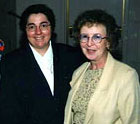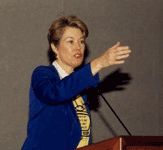Catholic Media Literacy Conference Draws 1100 Participants
|
|
April, 1998: Over 1100 teachers and administrators participated in a first-ever media literacy "mini-conference" held as an integral part of the annual convention of the National Catholic Educational Association (NCEA) at the Los Angeles convention center, April 14-17. Participants represented more than 200 Catholic schools and parishes around the U.S. including 90 in Southern California.
The mini-conference was organized by the LA-based Center for Media Literacy, a national non-profit organization, in collaboration with the NCEA, the Center for Religious Communications at the University of Dayton and Catholics in Media, a professional organization of lay women and men in the media industry. CML President and Founder, Elizabeth Thoman, CHM, chaired the event.
The 3-day conference consisted of an integrated series of 10 workshops, panel conferences and curriculum demonstrations led by Catholic media literacy experts from around the country as well as LA area teacher-practitioners trained by the CML's Felton Media Literacy Scholars Program. Topics covered included issues such as advertising and the consumer culture, gender and body image, a new look at TV violence and spirituality in the media.
One of the most acclaimed sessions featured a panel of writers, story consultants and directors working on popular television shows such as Home Improvement, Family Matters, Step by Step and Diff'rent Strokes. Moderated by Catholics in Media co-founder Patt Shea, the panel provided a behind-the-scenes look at the making of television and a better understanding of the economic imperatives that can influence or derail the creative process.
With over 8000 registrants, the NCEA convention is one of the largest educational meetings held each year in the United States. Holding a "mini-conference" within the venue of the NCEA was, according to Thoman, an opportunity not to be missed. The event proved to be one of the best-attended programs of the convention.
 "For teachers who might never have the financial resources to attend a stand-alone media literacy institute or conference, this was an ideal venue to introduce them to breadth and scope of the fast-growing media literacy field," she explained.
"For teachers who might never have the financial resources to attend a stand-alone media literacy institute or conference, this was an ideal venue to introduce them to breadth and scope of the fast-growing media literacy field," she explained.
The teaching of media literacy helps students apply skills of critical viewing and critical thinking to all mediated messages including those from television, movies, advertising, newspapers and magazines and now the Internet. "We want them to be able to question everything they see, hear and read," said Thoman. "It's really literacy for the 21st century."
With a support grant from the De La Salle Institute of the Brothers of the Christian Schools in Napa, California, the Center was also able to organize a display area where teachers could examine media literacy teaching materials and to provide a free copy of the acclaimed media literacy curriculum, CATHOLIC CONNECTIONS TO MEDIA LITERACY, to schools that sent two representatives to at least five workshops. More than 75 kits were distributed during the conference.
Response to the idea and content of the "mini-conference" were overwhelmingly positive. Anonymous evaluation comments noted:
 ". . . Wonderful! Lots of thought provoking information presented in an interesting and useful form."
". . . Wonderful! Lots of thought provoking information presented in an interesting and useful form."- "I didn't realize so much could be learned! Wow! Very illuminating."
- "I was not bombarded by a series of facts and figures, but rather empowered with significant knowledge and clear cut ways to help my students become critical viewers."
- "Make workshops for teachers (on media literacy) mandatory in all schools - worldwide!"
- "This topic is absolutely essential. . . Thanks for raising my awareness. I hope this will be a feature of NCEA every year no matter where it is."
The complete list of workshops and presenters included:
- "Media Literacy is not an Oxymoron: Critical Thinking for the 21st Century."
Elizabeth Thoman, CHM, Founder, Center for Media Literacy - "Media Literacy: Driver's Training for the Information Superhighway"
John Gunnin, mentor teacher, Centinela Valley School District - "Kids Talk TV: Introducing Media Literacy to Kids 9 - 11"
Angie Sims, Distance Learning Instructor, L.A. County Office of Education - "School Reform and Integrating Media Education into the Curriculum: Six Keys to Success"
Fran Trampiets, S.C., University of Dayton - "I Can't Buy That!: Advertising and the Consumer Culture"
Michael Danielson, Seattle Prep High School - "Media and the Message of Beauty"
Pamela Fomalont, Center for Media Literacy - "Confessions of a Prime Time Killer: A Veteran Actor Challenges TV Violence"
James Read, actor and educational consultant - "In the Beginning. . . is the Story: A Panel with People Who Make TV"
panel of TV writers and producers, moderated by Patt Shea, screenwriter - "Taking Back the Town Square: Building Media Literacy Collaborations"
Mary B. Hoffman, Media Coordinator, Nat'l Council of Churches - "God in the Box: Spirituality and the Media"
Rose Pacatte, FSP, Pauline Books & Media, Boston
The Center for Media Literacy, founded in 1989 as an outgrowth of Media&Values magazine, is a national advocacy organization for media literacy in the United States. With 2000 active members and a service base of over 7500 individuals and institutions, the Center offers a range of services including a direct mail catalog of books, videos and curriculum materials; leadership on issues such as violence in the media, tobacco and alcohol advertising and gender/body image; and innovative models and programs for teacher training. The Center's Internet website is www.medialit.net.



